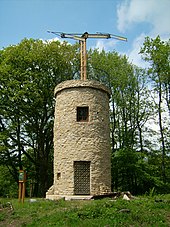
Back خط الإشارة Arabic Telegrafia òptica Catalan Optisk telegraf Danish Optische Telegrafie German Optika telegrafio Esperanto Telégrafo óptico Spanish Telegrafia optiko Basque Optinen lennätin Finnish Sémaphore (communication) French Telegrafía óptica Galician


An optical telegraph is a line of stations, typically towers, for the purpose of conveying textual information by means of visual signals (a form of optical communication). There are two main types of such systems; the semaphore telegraph which uses pivoted indicator arms and conveys information according to the direction the indicators point, and the shutter telegraph which uses panels that can be rotated to block or pass the light from the sky behind to convey information.
The most widely used system was the Chappe telegraph, which was invented in France in 1792 by Claude Chappe. It was popular in the late eighteenth to early nineteenth centuries.[1][2][3] Chappe used the term "télégraphe" to describe the mechanism he had invented – that is the origin of the English word "telegraph".[4] Lines of relay towers with a semaphore rig at the top were built within line of sight of each other, at separations of 5–20 miles (8–32 km). Operators at each tower would watch the neighboring tower through a telescope, and when the semaphore arms began to move spelling out a message, they would pass the message on to the next tower. This system was much faster than post riders for conveying a message over long distances, and also had cheaper long-term operating costs, once constructed. Half a century later, semaphore lines were replaced by the electrical telegraph, which was cheaper, faster, and more private. The line-of-sight distance between relay stations was limited by geography and weather, and prevented the optical telegraph from crossing wide expanses of water, unless a convenient island could be used for a relay station. A modern derivative of the semaphore system is flag semaphore, signalling with hand-held flags.
- ^ Burns 2004, Chapter 2: Semaphore Signalling
- ^ "Telegraph". Encyclopædia Britannica. Vol. 10 (6th ed.). 1824. pp. 645–651.
- ^ David Brewster, ed. (1832). "Telegraph". The Edinburgh Encyclopaedia. Vol. 17. pp. 664–667.
- ^ Axon, William (1880). "On the History of the word Telegraph". Proceedings of the Literary and Philosophical Society of Manchester. 19: 183. Retrieved 10 June 2023.